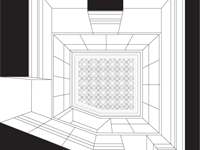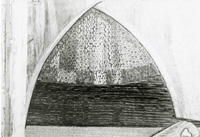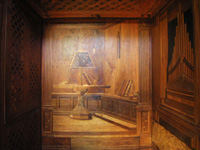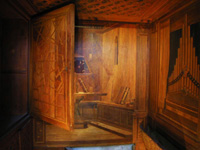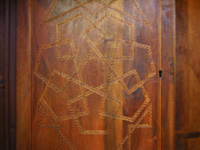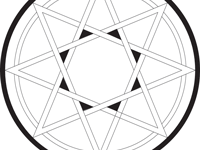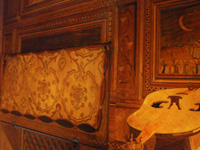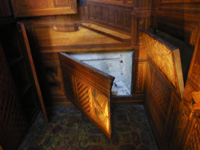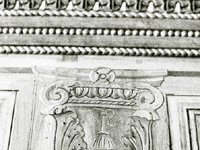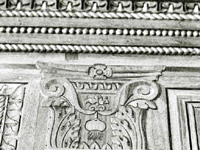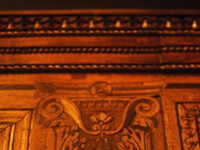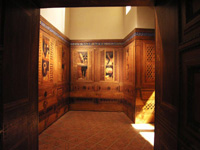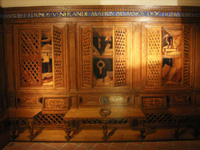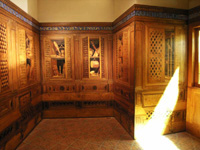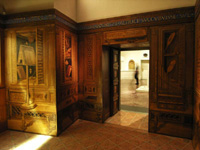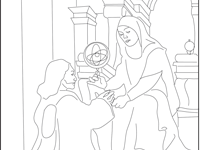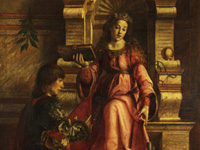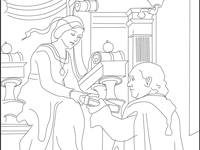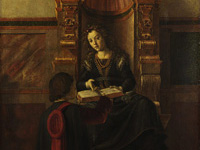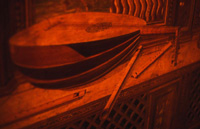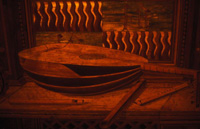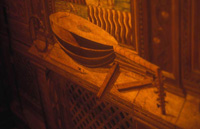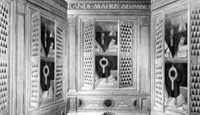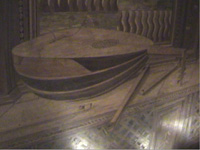This ark is like to an apothecary's shop, filled with a variety of all delights. You will seek nothing in it which you will not find, and when you find one thing, you will see many more disclosed to you. . . . Here the narrative of historical events is woven together, here the mysteries of the sacraments are found, here are laid out the successive stages of responses, judgments, meditations, contemplations, of good works, virtues, and rewards.—Hugh of St. Victor, "De arca Noe morali," 4.9.680B
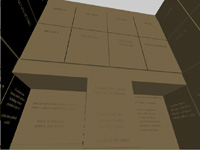 Urbino Studiolo Urbino Studiolo |
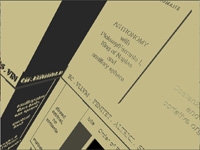 Gubbio Studiolo Gubbio Studiolo |
1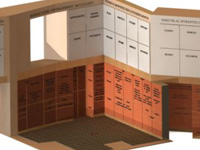 Studioli SlideshowAt first glance, the Urbino and Gubbio studioli appear quite similar. Though relatively small in footprint—14.8 and 13 square meters, respectively—both are tall spaces, fitted with decorated coffered ceilings set five meters above a terra-cotta tiled floor.1 This configuration provides large wall surfaces at intimate proximity, an ideal arrangement for a bold composition that invites closer inspection of its subtle and exacting craftsmanship. Each studiolo displayed a thematic cycle of oil paintings on the upper portion of its walls. At Urbino, portraits of 28 uomini illustri (illustrious men) represent Federico's intellectual and spiritual autobiography,2 whereas at Gubbio an allegorical ensemble dedicated to the liberal arts underscores an educational program. Both cycles were commenced by the Flemish master Justus van Ghent3 and completed by Pedro Berreguete of Spain. Though thematically common for their time, the particular subjects and arrangement of these paintings offer insight into Federico's character and valuable clues concerning the uses of the chambers.
Studioli SlideshowAt first glance, the Urbino and Gubbio studioli appear quite similar. Though relatively small in footprint—14.8 and 13 square meters, respectively—both are tall spaces, fitted with decorated coffered ceilings set five meters above a terra-cotta tiled floor.1 This configuration provides large wall surfaces at intimate proximity, an ideal arrangement for a bold composition that invites closer inspection of its subtle and exacting craftsmanship. Each studiolo displayed a thematic cycle of oil paintings on the upper portion of its walls. At Urbino, portraits of 28 uomini illustri (illustrious men) represent Federico's intellectual and spiritual autobiography,2 whereas at Gubbio an allegorical ensemble dedicated to the liberal arts underscores an educational program. Both cycles were commenced by the Flemish master Justus van Ghent3 and completed by Pedro Berreguete of Spain. Though thematically common for their time, the particular subjects and arrangement of these paintings offer insight into Federico's character and valuable clues concerning the uses of the chambers.
2The lower portion of each studiolo is paneled with illusionistic intarsia, ostensibly elaborating on Alberti's advice concerning the insulation of stone walls: "If you panel your walls with timber, and especially fir or even poplar, it will make the place healthier, warm enough in winter, and not too hot in summer."4 In weather as damp and chilling as Urbino's winter and as swelteringly hot as its summer, wood paneling would have been a welcome amenity for a room devoted to contemplation and intimate conviviality. This is no small detail: Dora Thornton notes that "heating was always a problem in studies."5
3
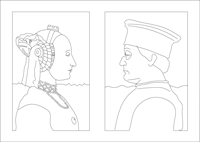 Fig. 2.1. Battista Sforza and Federico da Montefeltro.
Fig. 2.1. Battista Sforza and Federico da Montefeltro.
Extended Caption 1
With remarkable veracity, the intarsia in each studiolo depicts a series of low benches and book presses6 fitted with latticework doors (some closed, some ajar) containing select books, scientific and musical instruments, armor and weaponry, and family crests of the Montefeltro and the numerous honors bestowed on Federico during his military and political career. Today, visitors to the studioli may experience the "privileged" vantage that an otherwise tragic mishap had afforded the duke. In 1451, Federico's right eye was destroyed during a festival joust, an event he interpreted as divine retribution for youthful misdeeds. Although dismayed at his damaged sight, Federico's monocular vision would actually have enhanced the clarity of the intarsiated trompe l'oeil, an effect that a modern observer may appreciate by exploring either studiolo with one eye closed.
2.1 The Urbino Studiolo: A Visitor's Perspective
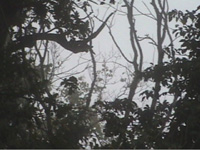 Urbino Day Urbino Day |
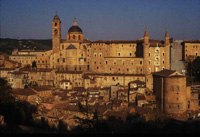 Fig. 2.2. The city of Urbino and the ducal palace. Fig. 2.2. The city of Urbino and the ducal palace. |
4The integration of public and private in the organization of the Urbino palace reveals as much about Federico's unique approach to governance as his interests in history and innovative architecture. Instead of building his palace as a hermetic fortress, as did many of his contemporaries, Federico and his architects conceived, in Castiglione's words, a palace "furnished . . . with everything suitable that it seemed not a palace but a city in the form of a palace."7 The convergence of the civic and domestic realms depicted by this statement is not exaggerated: with the exception of the private apartments and the duchess's wing, to which only Federico and Ottaviano held the keys,8 Urbino's citizens enjoyed access to the ducal palace that was uncommon for its time. This degree of openness likely reflected the pact between Federico and his subjects, formed as a consequence of the demise of his younger (legitimate) brother, Oddantonio, who after less than one year of imprudent rule was assassinated in his bedchamber by a group of citizens, who reputedly cut off the duke's penis and stuffed it into his mouth.9
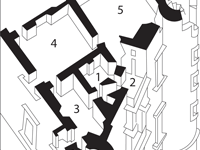 Fig. 2.3. Axonometric detail of the Urbino ducal palace. Fig. 2.3. Axonometric detail of the Urbino ducal palace. |
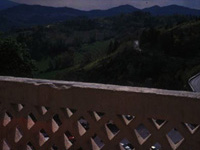 Fig. 2.4. View from loggia outside studiolo. Fig. 2.4. View from loggia outside studiolo. |
5Like a valve, the studiolo was positioned between the public and private zones of the palace—more precisely, between the duke's bedchambers and the Sala d'Udienze, or council chamber. The studiolo also occupied a liminal perch between the palace/city and the dukedom, offering egress to an exterior loggia that provides a generous view of the lands surrounding Urbino. Although little information is available from contemporary sources concerning uses of the Gubbio studiolo, permanently installed at the Metropolitan Museum of Art in New York, we are fortunate to have inherited valuable, if slender, accounts of the Urbino studiolo and clues about its role in Federico's daily activities.
Besides the [ducal] library there is a small chamber, designated the studio[lo], in the prince's apartment, around which are wooden benches with their legs and a table in the middle; all made of the most diligent craftsmanship in intarsia and intaglio. From the intarsia—which covers the wall from the floor to the height of a man or a little more—up to the ceiling, the walls are subdivided by a number of paintings [28]. Each painting portrays a famous ancient or modern writer, and includes a brief note of praise [an encomium] summarising their life.10
Although historically useful, this description by the late-sixteenth-century biographer Bernardino Baldi scarcely conveys the character of the Urbino studiolo, from the visual warmth of its materials to the energizing profusion of its images. Entering the studiolo by its "public" southwest door, which connects to the Sala d'Udienza, visitors inevitably first wonder, "Where to begin?" Every surface—and every surface-within-a-surface—is adorned with exquisite craftsmanship.
6In addition to its terra-cotta tiled floor and gilt ceiling, the studiolo is composed of two distinct zones: the polychromatic portraits of twenty-eight uomini illustri and the honey-toned intarsia paneling below. In turn, the portraits are arranged in two tiers of 14, and the intarsia is divided into three levels, with architectural niches and cabinets (two shelves each), benches set on a low platform, and the dado between.
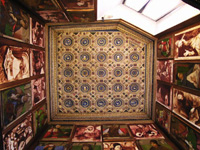 Fig. 2.5. View of ceiling and gallery of 28 illustrious men, Urbino studiolo. Fig. 2.5. View of ceiling and gallery of 28 illustrious men, Urbino studiolo. |
7Immediately below the ceiling, whose coffers house Federico's initials and devices, a dedicatory text encircles the room in a band of blue with gold lettering:
FEDERICVS . MONFELTRIVS . DVX . VURBINI . MONTISFERETRI . AC . DVRANTIS . COMES . SERENISSMI . REGIS . SICILIE . CAPITANEVS . GENERALIS . SANCTEQVE . ROMANE . ECCLESIE . CONFALONERIVS . MCCCCLXXVI .
[Federico da Montefeltro, Duke of Urbino, Count of San Leo and Durante, Captain General of the Very Serene King of Sicily, and Gonfalonier of the Holy Roman Church. 1476]
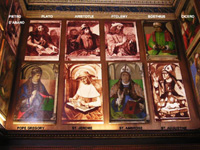 Fig. 2.6. Illustrious men at north wall of Urbino studiolo. Fig. 2.6. Illustrious men at north wall of Urbino studiolo.North Wall Encomia |
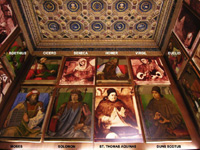 Fig. 2.7. Illustrious men at east wall of Urbino studiolo. Fig. 2.7. Illustrious men at east wall of Urbino studiolo.East Wall Encomia |
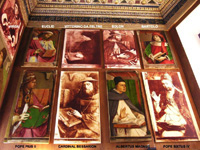 Fig. 2.8. Illustrious men at south wall of Urbino studiolo. Fig. 2.8. Illustrious men at south wall of Urbino studiolo.South Wall Encomia |
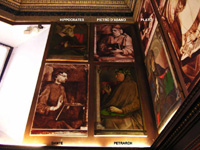 Fig. 2.9. Illustrious men at west wall of Urbino studiolo. Fig. 2.9. Illustrious men at west wall of Urbino studiolo.West Wall Encomia |
8Beginning in the northwest corner, directly opposite the threshold to the adjacent Sala d'Udienza, this text gives us a straightforward point of orientation, a place to "catch hold" amid the overwhelming abundance of images. Following the path of text around the chamber, we are drawn ineluctably toward the room's center. Completing a full rotation at the dedicatory date,11 our gaze might naturally descend to the colorful portraits below, each featuring an illustrious scholar seated in an architectural setting. Federico's guests, even if they could not discern the names and encomia (prominently) inscribed on the portraits, would have recognized most of the uomini illustri through quattrocento artistic conventions used for each subject's clothing, accessories, and gestures. A cursory overview of the group points up the broad representation of intellectual disciplines and a striking balance of Christian and non-Christian heroes, organized (for the most part) by the lower and upper tiers.12
9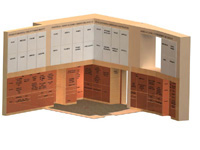 Fig. 2.10. Directly beneath "FEDERICVS" we find Plato and Aristotle placed side-by-side. Having completed one (or perhaps two) further rotation(s) in consideration of the portraits and their commentaries, our gaze returns to the north wall intarsia, where it alights on further text. A bit of paper, nailed to the facing of a shelf like a reminder, bears the phrase "virtutibus itur ad astra." Elsewhere in the same wall, emblazoned on books, are the names of Virgil, Homer, Cicero (TVLIO), Seneca, and Duns Scotus, whose portraits are included among the uomini illustri. Alongside is a Bible, perhaps the one in Greek, Hebrew, and Latin that Federico acquired in 1472 during the spoliation of Volterra.
Fig. 2.10. Directly beneath "FEDERICVS" we find Plato and Aristotle placed side-by-side. Having completed one (or perhaps two) further rotation(s) in consideration of the portraits and their commentaries, our gaze returns to the north wall intarsia, where it alights on further text. A bit of paper, nailed to the facing of a shelf like a reminder, bears the phrase "virtutibus itur ad astra." Elsewhere in the same wall, emblazoned on books, are the names of Virgil, Homer, Cicero (TVLIO), Seneca, and Duns Scotus, whose portraits are included among the uomini illustri. Alongside is a Bible, perhaps the one in Greek, Hebrew, and Latin that Federico acquired in 1472 during the spoliation of Volterra.
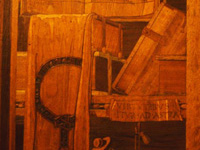 Fig. 2.11. Cabinet, north wall. Fig. 2.11. Cabinet, north wall. |
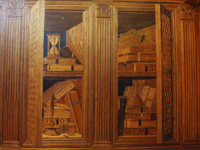 Fig. 2.12. Cabinet, north wall. Fig. 2.12. Cabinet, north wall. |
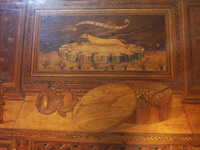 Fig. 2.13. Candied fruit on bench, north wall. Fig. 2.13. Candied fruit on bench, north wall. |
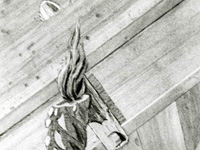 Fig. 2.14. Lit candle, north wall. Fig. 2.14. Lit candle, north wall. |
10From the general appearance of the intarsia, with its opened cabinet doors, upturned seats, and the array of items disposed on its benches, we might imagine that we have entered the studiolo while it was in use. It is as if Federico has just stepped out and will be returning shortly. We might, in fact, envision that the duke had entered the room after a day of military toil, laid his arms to rest, removed and hung his armor in the northeast alcove, and donned the robes of a humanist scholar in preparation for contemplative pursuits. Judging from the two spoons in an opened container of candied fruit, it appears that he has company. Is one of the spoons meant for us? A candle has been lit long enough for its wax to drip. Notes have been jotted onto a folded scrap of paper nearby, and the hourglass above will soon need to be turned over.
11It appears that Federico and his guest(s) have been listening to music: two musical scores are opened in separate cabinets, and ten of the 14 instruments in the chamber are laid out, almost haphazardly, on the benches. A sword and mace lean against two upturned seats (near the duke's and visitor's entrance, respectively), while in two other locations seats are raised as if to provide easier access to opened cabinets nearby. For all of the benches surrounding the chamber, there is little room to "sit."
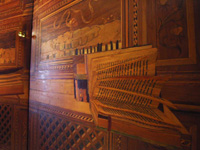 Fig. 2.15. Twenty-four objects are displayed on the benches at Urbino. Fig. 2.15. Twenty-four objects are displayed on the benches at Urbino. |
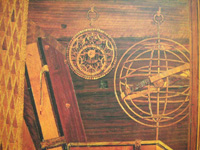 Fig. 2.16. Astrolabe and armillary sphere, Urbino studiolo. Fig. 2.16. Astrolabe and armillary sphere, Urbino studiolo. |
12 Our gaze pours over the contents of the cabinets. In addition to the musical instruments and ubiquitous books, various items associated with the liberal arts, muses, and virtues are found alongside precious and commonplace instruments of science and scholarship. Many of these images have been encountered elsewhere in the palace, en route to the studiolo. Eleven hooks in the cabinets support a dagger, a scopetta (whisk broom), Federico's armor (occupying five hooks), an astrolabe, an armillary sphere, a tablet, and a birdcage. One hook is empty, suggesting that its normal occupant is in use and might be found elsewhere—on the bench, perhaps? And, in a tour-de-force of subtle craftsmanship, a rectangular glass mirror dangles by a rope from a pilaster capital near the visitor's entrance, "blocking" the "swing" of an adjacent cabinet door.
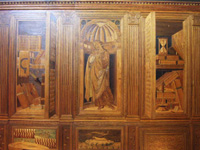 Fig. 2.17. Hope, north wall, Urbino studiolo. Fig. 2.17. Hope, north wall, Urbino studiolo. |
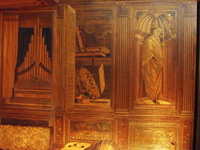 Fig. 2.18. Faith, south wall, Urbino studiolo. Fig. 2.18. Faith, south wall, Urbino studiolo. |
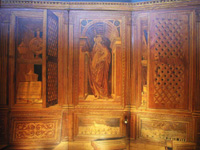 Fig. 2.19. Charity, west wall, Urbino studiolo. Fig. 2.19. Charity, west wall, Urbino studiolo. | |
13Four miniaturized human figures inhabit the intarsia, ensconced among the cabinets. Centered in the north, south, and west walls are the three theological virtues, Hope, Faith, and Charity, respectively; we recognize them from the Door of the Virtues, located elsewhere in the palace at the entrance to the Appartamento della Iole.13 The settings for Hope and Faith are semicircular, while Charity occupies a vaulted threshold that appears to lead somewhere beyond. The fourth figure, diagonally opposite from the visitor's entrance, is Duke Federico, depicted in humanist robes holding a spear with its point turned downward.
14In addition to the illusionistic niches and cabinets, there are physical recesses in the intarsia at each corner of the studiolo. Two of these are thresholds, leading to the Sala d'Udienza in the southwest corner and the duke's bedchambers in the northwest. At the east wall, two other recesses are separated by what further inspection reveals to be an actual book press. To the left, in a "curtained" alcove adjacent to Federico's half-scale portrait, we find his armor represented at full-scale, its chain mail glittering. To the right of the book press, we discover a studiolo in miniature, equipped with its own benches, lectern, books, hourglass, illuminated lantern, and dedicatory frieze. Adjacent to the studiolo-within-a-studiolo is the third "curtained" alcove in the chamber, containing a positive organ made by Juhani Castellano, whose name is inscribed below its keys.
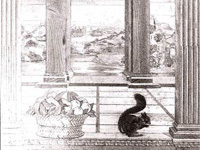 Fig. 2.24. Civic space at the center of the east wall, Urbino studiolo. Fig. 2.24. Civic space at the center of the east wall, Urbino studiolo. |
15 In the central panel of the east wall, we view a city in the distance through the arches of an empty loggia. A squirrel and a basket of fruit sit on the ledge of a window through which the observer (the occupant of the studiolo) gazes. The squirrel busies itself with a nut, and the basket offers the observer the ripe bounties harvested from the lands seen beyond the arcade.
16Exploring further, we discover shelves at either side of the book press: nearest the armor, they are shallow and openly accessible, whereas those on the miniature studiolo side, concealed by a door, are deeper and more spacious. The inside of the cabinet door is inlaid with a heptagonal figure drawn from a single, infinitely recursive line. This sevenfold figure is unusual: although arabesque in its tracery, most Islamic geometries are based on a fourfold order of interlocking squares and octagons or a threefold order of triangles and hexagons. Nearby, a seven-lobed thistle- or artichoke-like flower is found in the brocade decoration of an intarsiated bench cushion, a pattern also found in the green textile covering the steps in the Liberal Arts oil portraits at Gubbio.14 Together with a panel beneath the miniature studiolo, this portion of the intarsia actually flips down to form a bench and lectern configuration—the "table in the middle" of Baldi's description?
17Like the coffers overhead, the dado presents Federico's initials and the devices of the Montefeltro found throughout the palace. Two of these emblems, the scopetta and the exploding grenade,15 also adorn pilaster capitals in the north wall while a third, a horse's bridle, does not appear elsewhere in the Urbino studiolo. It will be seen in the dado at Gubbio.
18 Several further cabinets are shown at the east wall, below seat-level. In addition to the actual shelves at either side of the book press, a few books are visible below the squirrel and fruit basket, and a few tapers—one ignited—are found beneath the miniature studiolo. Examining the bench legs more closely, we notice wheels that are fashioned for movement: they are fitted with hubs, as if for axles. Shadows cast by the bench legs lead us to wonder at their source.
19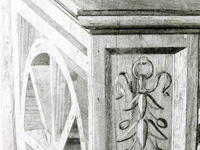 Fig. 2.33. Bench wheels, Urbino studiolo.Above the intarsia of the west wall, a large window admits late afternoon sunlight, at which time the room becomes golden ocher. The canted sides of the window permit enough light to illuminate the interior but not so much that it becomes overheated. In addition to the illusionistic depth provided by the intarsia and paintings, which prevent the chamber from feeling too "close," the arrangement of multiple doors provides ample ventilation, consistent with Alberti's suggestion that a room be prepared for summer conditions, since it is more difficult to cool than to heat a space. In fact, the ruffled pages of an opened book lead a curious observer to discover the third door of the studiolo, concealed behind the figure of Charity.
Fig. 2.33. Bench wheels, Urbino studiolo.Above the intarsia of the west wall, a large window admits late afternoon sunlight, at which time the room becomes golden ocher. The canted sides of the window permit enough light to illuminate the interior but not so much that it becomes overheated. In addition to the illusionistic depth provided by the intarsia and paintings, which prevent the chamber from feeling too "close," the arrangement of multiple doors provides ample ventilation, consistent with Alberti's suggestion that a room be prepared for summer conditions, since it is more difficult to cool than to heat a space. In fact, the ruffled pages of an opened book lead a curious observer to discover the third door of the studiolo, concealed behind the figure of Charity.
 Fig. 2.34. View from loggia outside studiolo. Fig. 2.34. View from loggia outside studiolo. |
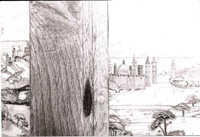 Fig. 2.35. Detail of distant city, east wall, Urbino studiolo. Fig. 2.35. Detail of distant city, east wall, Urbino studiolo. |
20 We step out onto the loggia. The vista vaguely recalls the background landscape in the central panel of the east wall, but is the depicted city Urbino?16 And if not, which city might it be?
^top2.2 The Gubbio Studiolo
21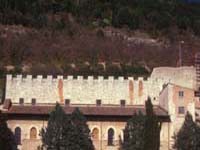 Fig. 2.36. View of Gubbio ducal palace.Although secondary in political importance to Urbino, Gubbio was the birthplace of Federico and his son, Guidobaldo, and therefore highly significant to the Montefeltro for reasons of dynastic continuity. Moreover, following Battista Sforza's marriage to Federico in 1460, Gubbio became the duchess's favorite place of residence. It is possible then, as Luciano Cheles has suggested,17 that the renovation of the palace by Francesco di Giorgio served to commemorate the duchess as well as to celebrate the birthplace of the duke and his heir.
Fig. 2.36. View of Gubbio ducal palace.Although secondary in political importance to Urbino, Gubbio was the birthplace of Federico and his son, Guidobaldo, and therefore highly significant to the Montefeltro for reasons of dynastic continuity. Moreover, following Battista Sforza's marriage to Federico in 1460, Gubbio became the duchess's favorite place of residence. It is possible then, as Luciano Cheles has suggested,17 that the renovation of the palace by Francesco di Giorgio served to commemorate the duchess as well as to celebrate the birthplace of the duke and his heir.
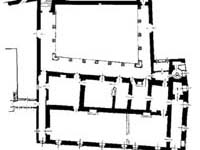 Fig. 2.37. Plan of Gubbio ducal palace, with studiolo noted as Room 1. Fig. 2.37. Plan of Gubbio ducal palace, with studiolo noted as Room 1. |
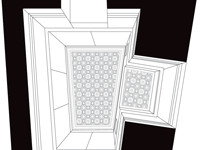 Fig. 2.38. Worm's eye view of the Gubbio studiolo, drawn by author and Amelia Amelia. Fig. 2.38. Worm's eye view of the Gubbio studiolo, drawn by author and Amelia Amelia. |
 Gubbio Studiolo Gubbio Studiolo |
 Studioli Slideshow Studioli Slideshow |
22Although the studioli are in many ways akin, there are subtle differences. Unlike the Urbino studiolo, a between space par excellence, the Gubbio studiolo is a more private cul-de-sac, situated at one end of a long gallery (Room #1 in fig. 2.37) that may have been used as a library and audience chamber.18 From this arrangement, it is likely that the studiolo served in both an official and leisurely capacity, as at Urbino. At Gubbio, however, there is a single entrance for the duke and his visitors and only one recess in the chamber, a window niche in the southeast wall. Also, the intarsia of the Gubbio studiolo is fixed entirely. There are no hidden cabinets or bookshelves, no concealed doors or panels that fold out into "furniture." Because there are no contemporary accounts like those offered by Vespasiano about the Urbino "closet,"19 it is more challenging to discern precise uses of the Gubbio studiolo. Nonetheless, several clues point to underlying significances.
23The most apparent differences between the studioli are captured in their Latin inscriptions and paintings. As compared with Urbino's text, which is located near the ceiling, the inscription at Gubbio encircles the room mid-wall in a band of blue and gold over the intarsia. Where Urbino's text offers a dedicatory introduction to Duke Federico, the Latin inscription at Gubbio is a distich dedicated to the liberal arts, composed by court scholar Federico Veterani.20 It proceeds:
ASPICIS.ETERNOS.VENERANDE.MATRIS.ALUMNOS.
DOCTRINA.EXCELSOS.INGENIOQ.VIROS.
UT.NUDA.CERVICE.CADANT.ANTE.[ORA.PARENTIS.
SUPPLIC]ITER.FLEXO.PROCUBUERE.GENU.
IUSTITIA.PIETAS.VINCIT.REVERENDA.NEC.ULLUM.
POENITET.ALTRICI.SUCCUBUISSES.SUE.
You see how the eternal students of the Venerable Mother
Men exalted in learning and in genius
Fall forward, suppliantly with bared head
And bended knee, before [the face of their parent].
With the help of Justice, reverend Piety prevails
And none regrets having submitted to his foster mother.21
24Instead of Urbino's gallery of illustrious men, Gubbio featured a cycle of seven allegorical paintings, each depicting a liberal art as a goddess who offers a manuscript or symbolic object to a mortal. The arrangement of these portraits is a matter of continued debate,22 since images of only four of the seven have survived: Ferrante I, king of Naples (as Ptolemy), with Astronomy, Costanzo Sforza with Music, Federico with Dialectic, and Guidobaldo with Rhetoric.23 Nonetheless, a significant clue may be deduced from these last two portraits.
25 In Dialectic, Duke Federico is shown genuflecting before the goddess while receiving (or returning) a closed book. Curiously, Federico's gaze is focused not on the goddess Dialectic but beyond the frame to the adjacent portrait at the center of the northwest wall which depicts his son receiving an opened book from Rhetoric. The goddess gestures to the verso page while training her gaze upon us, the observers who would be standing in the center of the chamber. From this energized position, we can imagine ourselves in the shoes of the young prince—his own image fixed eternally under the duke's watchful gaze—raising his own eyes to meet those of the placidly stern goddess of Rhetoric. The incentive to attend to his studies is palpable.
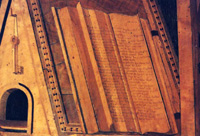 Fig. 2.48. Lectern and opened manuscript of Virgil's Aeneid, Gubbio studiolo. Fig. 2.48. Lectern and opened manuscript of Virgil's Aeneid, Gubbio studiolo. |
26Another clue is found in the only section of intarsia not immediately visible on entering the chamber, in the window niche. Here we find the image of a lectern, set on the bench, that displays a legible manuscript of Virgil's Aeneid,24 illusionistically opened to the passage describing the death of Pallas:
Every man's last day is fixed
Lifetimes are brief and not to be regained,
For all mankind. But by their deeds to make
Their fame last: that is labor for the brave.
Although this passage likely refers to the death of Duke Federico, on 10 September 1482, its exhortatory tone is akin to the fixing gaze of the goddess Rhetoric. Suspended directly above the lectern, a circular mirror bears the letters G.BA.LDO.DX, signifying Duke Guidobaldo.
27Since Federico's personal insignias are found elsewhere in the chamber, it seems likely that the studiolo was completed following the duke's death, as Raggio and Wilmering have surmised. We might also take a longer view that the program for the chamber had been conceived (and adapted) in preparation for the inevitable transference of the dukedom to, as Castiglione would describe, "a motherless little boy of ten years."25 Regardless of the exact timing, the educational theme of the studiolo, underscored by the portraits of the Liberal Arts, would have been most appropriate for a young prince.
28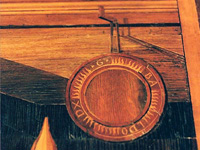 Fig. 2.49. Mirror with Guidobaldo's initials. Considered in this light, the composure of the Gubbio studiolo is slightly more organized than at Urbino: its contents appear more select and less casually "strewn" about. Although seats are raised in four locations, as at Urbino, the benches display a third of the objects. There are also a third of the books and half the number of items found in Urbino's cabinets.26 Although music remains the dominant discipline, with 13 instruments evenly dispersed and an opened manuscript in a northwest cabinet,27 only a portative organ is readily at hand. Because of its size, it appears that the organ might ordinarily be stored alongside a birdcage (housing only one parrot) that is set in one of the two window-niche cabinets, which have no shelves. Evocative details suggest that the other cabinet might in some manner offer storage for the lectern.28 These matching cabinets are visually distinguished from the others by their surrounding ornament, which consists of numerous discs threaded together at their center points. Several other objects—including a mazzocchio,29 a sword, a butterfly,30 two bundles of fasces,31 and a book—are widely spaced around the benches, leaving ample room for the eye to rest.
Fig. 2.49. Mirror with Guidobaldo's initials. Considered in this light, the composure of the Gubbio studiolo is slightly more organized than at Urbino: its contents appear more select and less casually "strewn" about. Although seats are raised in four locations, as at Urbino, the benches display a third of the objects. There are also a third of the books and half the number of items found in Urbino's cabinets.26 Although music remains the dominant discipline, with 13 instruments evenly dispersed and an opened manuscript in a northwest cabinet,27 only a portative organ is readily at hand. Because of its size, it appears that the organ might ordinarily be stored alongside a birdcage (housing only one parrot) that is set in one of the two window-niche cabinets, which have no shelves. Evocative details suggest that the other cabinet might in some manner offer storage for the lectern.28 These matching cabinets are visually distinguished from the others by their surrounding ornament, which consists of numerous discs threaded together at their center points. Several other objects—including a mazzocchio,29 a sword, a butterfly,30 two bundles of fasces,31 and a book—are widely spaced around the benches, leaving ample room for the eye to rest.
29There are no human figures inlaid at Gubbio. Nor is there the range of illusionistic "depth" found in the Urbino intarsia. Instead, there are 13 cabinets, 12 of whose latticed shutters were left eternally "open" to reveal their contents. Fifteen objects are suspended from hooks that are spaced more regularly among the cabinets than at Urbino. All but one are occupied.32 Hanging items including a hunting horn, a pen and ink flask set, the scopetta, the Order of the Garter, a jingle ring, a harp's tuning key, an architect's set square/level, a dagger, a tabor, a pair of gauntlets, a circular mirror, papal keys, an eyeglass case, an armillary sphere, and a quadrant.
30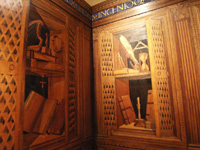 Fig. 2.50. North corner of Gubbio studiolo.A comparison with "hooked" items at Urbino provokes the following speculations. The empty hook at Urbino is probably designated for the jingle ring. The duke's elevation to the Order of the Garter was clearly one of his most prized achievements, since it is the only object in either studiolo to be fixed permanently by its hook. Mirrors and armillary spheres, too, were highly valued and prominently displayed. At Gubbio, the hooks for both are located not inside but rather above their cabinets, a condition that would influence the "operability" of the respective cabinet doors, as with the rectangular glass mirror at Urbino.33 Also, it is worth keeping in mind that many of these "suspended" objects are shaped like letters of the alphabet.
Fig. 2.50. North corner of Gubbio studiolo.A comparison with "hooked" items at Urbino provokes the following speculations. The empty hook at Urbino is probably designated for the jingle ring. The duke's elevation to the Order of the Garter was clearly one of his most prized achievements, since it is the only object in either studiolo to be fixed permanently by its hook. Mirrors and armillary spheres, too, were highly valued and prominently displayed. At Gubbio, the hooks for both are located not inside but rather above their cabinets, a condition that would influence the "operability" of the respective cabinet doors, as with the rectangular glass mirror at Urbino.33 Also, it is worth keeping in mind that many of these "suspended" objects are shaped like letters of the alphabet.
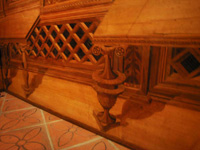 Fig. 2.51. Bench legs, Gubbio studiolo. Fig. 2.51. Bench legs, Gubbio studiolo. |
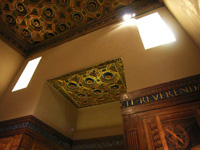 Fig. 2.52. Ceiling and funnel windows, Gubbio studiolo. Fig. 2.52. Ceiling and funnel windows, Gubbio studiolo. |
 Fig. 2.53. Exterior façade of Gubbio studiolo. Fig. 2.53. Exterior façade of Gubbio studiolo. |
|
31Dwelling on other details in the intarsia, we discern that shadows cast by the 21 bench legs and within the cabinets correspond to direct light admitted by the southeast wall through the window niche and two smaller light funnels located discreetly overhead. Scrutiny of these shadows, more crisply rendered than those at Urbino, does not point to a specific "frozen" instant; rather, the shadows evoke the transit of early to late morning light.34 As at Urbino, wheels are found below the benches. Here, however, subdivided discs encircle eight of the legs horizontally. Below the benches there are no cabinets.
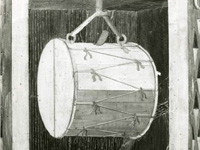 Fig. 2.54. Pipe and tabor, candied fruits, Gubbio studiolo. Fig. 2.54. Pipe and tabor, candied fruits, Gubbio studiolo. |
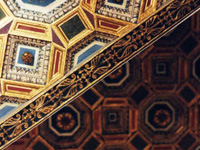 Fig. 2.55. Detail of ceiling, Gubbio studiolo. Fig. 2.55. Detail of ceiling, Gubbio studiolo. |
32Although the studioli are equally "cerebral" and "wondrous," the pronounced formality at Gubbio would have been particularly conducive for cultivating right and orderly mental habits in a young prince.35 Guidobaldo's youth appears to have influenced two other details in the chamber. Where the candied fruit are openly "shared" at Urbino, at Gubbio they are more discreetly tucked away in one of the cabinets, like the promise of reward. This detail would be most appropriate: where Federico would magnanimously share his life's rewards through works that display the princely magnificentia recommended by Alberti, Castiglione, and Machiavelli, Guidobaldo had yet to earn his own, a matter that is reflected in the ceiling ornament.36 Instead of the various emblems and awards displayed at Urbino, Gubbio's ceiling coffers are decorated with hanging rosettes.
^top2.3 A Phenomenological Reading of the Studioli
33Many layers of experience await visitors to the studioli, whether they proceed by curiosity and instinct or follow the narrative of a manual or docent. Most present-day visitors are drawn immediately to examine the intarsia at close range: there is an almost overpowering desire to touch the wood paneling for the wonder of its craftsmanship, a tactile component foreshortened by museum etiquette. Visitors may also "enter" by iconographic familiarity with various images or through the Latin texts woven into both chambers. Others intuitively search the studioli architecture for standpoints from which the composition(s) might be best appreciated. However and wherever a visitor begins, it is swiftly apparent that there is so much to absorb that a full reading of either chamber, were it possible, would exhaust even the most rapacious observer. Clearly, the studioli were intended for slow and pleasurable digestion.
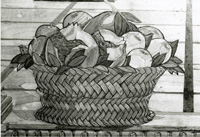 Fig. 2.56. Basket with fruit, Urbino studiolo. Fig. 2.56. Basket with fruit, Urbino studiolo. |
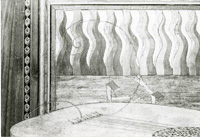 Fig. 2.57. Lute with broken strings, Urbino studiolo. Fig. 2.57. Lute with broken strings, Urbino studiolo. |
34 We can easily lose ourselves in the extraordinary detail of the intarsia alone. Pomegranates burst with ripeness. "Glass" and "metal" surfaces sparkle. Even the broken strings of the lutes and harp are rendered with highlights. We find ourselves counting the seeds scattered at the bottom of the Urbino birdcage (there are 13). Amid the many images of transience—the burning candle and taper, the dwindling sands of the hourglass—we imagine the scent of melting wax and the parrots' chatter, accompanied by the mechanisms of the adjacent clock. How would a first-time visitor to one of the studioli have oriented him- or herself in such a private, yet openly displayed chamber?37 For Federico's guests, who were well versed in Latin, any available text would have provided straightforward points of departure. In fact, the influence of textual habits reveals a fundamental way that Federico's guests were likely to have experienced the studioli.
35The preceding accounts of the Urbino and Gubbio studioli demonstrate the ancient rhetorical practice of ekphrasis, by which a narrative rendering proceeds in a "relaxed" manner from top to bottom in a downward left-to-right spiral. En route, the "reader" encounters other forms of composition—encomia, proverbs, and poetry—that produce eddies in an otherwise continuous flow that draws the eye (and body) around the chambers. Although the duke and his visitors shared this fundamental habit of reading and description,38 it was by no means the only way of navigating the studioli. For a quattrocento observer, whose education fostered this skill as one of the 14 preparatory exercises of the progymnasmata,39 the density and character of images and text in the studioli provided a "Rhetoricus"40 with not one but endless routes for narrative composition. Careful consideration of these figures reveals clues to the underlying organization of the studioli.
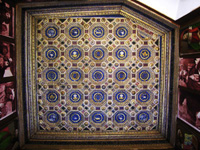 Fig. 2.58. Ceiling, Urbino studiolo. Fig. 2.58. Ceiling, Urbino studiolo. |
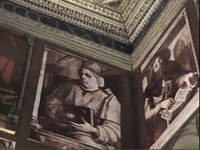 Ekphrasis, Urbino Studiolo Ekphrasis, Urbino Studiolo |
36At Urbino, there are two overlapping orientations. The first, emphasized by text and heraldic emblems in the north wall,41 corresponds to the visitor's entrance as a narrative "starting point" (or status). The other, overarching order corroborates with the duke's entrance. If we consider the ceiling with care, we discern that the emblems within its coffers are uniformly oriented to be viewed while facing the east wall, an arrangement that projects a "destination" (or skopos)42 for the duke and, perhaps, for all of his guests.
37Because the Gubbio studiolo has only one entry and the status of Veterani's distych is not immediately opposite the entrance, the visitor enters searching for a visual grapple-hold. The ceiling rosettes yield no direction. As with the duke's entrance at Urbino, however, the text begins in the corner to the immediate left (with the word Aspicis), an arrangement that suggests an idealized choreography by which the duke and his guests would enter and turn to face the northwest wall to "begin" viewing the contents of the chamber. The primacy of this wall is evident from the centered, vertical alignment of the mazzocchio and the Order of the Garter, which extends upward to the fixing gaze of the goddess Rhetoric.
38 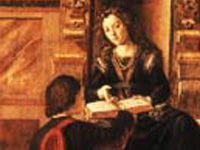 Fig. 2.59. Montage of vertical axis in northwest wall, Gubbio studiolo.
Each studiolo is fitted with ornamental details that suggest a prime site, or standpoint, from which the trompe l'oeil snaps into place and feels "right."43 At Urbino's, roughly square in plan, this standpoint is readily ascertained at the chamber's center. At Gubbio's, which is trapezoidal, the prime site is established with more subtlety. Although the centered, vertical axis in the northwest wall provides a strong indication of its whereabouts, there are more precisely calibrated details in the window niche. Closer inspection of the ornamental surrounds of threaded discs suggests an ideal viewpoint approximately one step back into the chamber from the window niche. One of these discs, at 168 centimeters above the floor, also reveals an ideal height for viewing the chamber.44 Rotating on the center-point to face the northwest wall, we meet the gaze of Rhetoric, fastening us into the spatial orthography of the studiolo architecture.
Fig. 2.59. Montage of vertical axis in northwest wall, Gubbio studiolo.
Each studiolo is fitted with ornamental details that suggest a prime site, or standpoint, from which the trompe l'oeil snaps into place and feels "right."43 At Urbino's, roughly square in plan, this standpoint is readily ascertained at the chamber's center. At Gubbio's, which is trapezoidal, the prime site is established with more subtlety. Although the centered, vertical axis in the northwest wall provides a strong indication of its whereabouts, there are more precisely calibrated details in the window niche. Closer inspection of the ornamental surrounds of threaded discs suggests an ideal viewpoint approximately one step back into the chamber from the window niche. One of these discs, at 168 centimeters above the floor, also reveals an ideal height for viewing the chamber.44 Rotating on the center-point to face the northwest wall, we meet the gaze of Rhetoric, fastening us into the spatial orthography of the studiolo architecture.
39 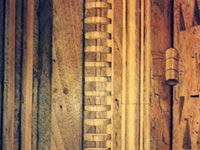 Fig. 2.60. Threaded disc surrounds, Gubbio studiolo.More elusive than the prime sites are certain optical effects that are detectable only when moving about the rooms. Shadows from the mace's tip at Urbino, for example, "appear" and "disappear" depending on our position. Other objects in the composition, such as the flutes and recorders on the bench, appear to "follow" in concert as we traverse the chamber. Likewise, the latticed cabinet shutters in both studioli "swing" open and close with our movement across the room, evoking the uncanny sensation that our eyes are manipulating the "contents" of the rooms.
Fig. 2.60. Threaded disc surrounds, Gubbio studiolo.More elusive than the prime sites are certain optical effects that are detectable only when moving about the rooms. Shadows from the mace's tip at Urbino, for example, "appear" and "disappear" depending on our position. Other objects in the composition, such as the flutes and recorders on the bench, appear to "follow" in concert as we traverse the chamber. Likewise, the latticed cabinet shutters in both studioli "swing" open and close with our movement across the room, evoking the uncanny sensation that our eyes are manipulating the "contents" of the rooms.
40This physical and mental experience is likely not far removed from the "certain experience of sense" Nicholas of Cusa described in De visione Dei (1453), a meditation manual that employs the inescapable gaze of a religious icon as a metaphor for the "omnivoyant" gaze of God. Referring to a work of Roger van der Weyden, Cusa marvels that the icon's eyes appear to follow him as he moves about the room while they simultaneously remain fixed on another person who stands motionless.45 On one hand, Cusa considers this phenomenon to exemplify the limited nature of human vision—its capacity to be deceived.46 Yet he also sees this frailty as an ultimate strength, providing adepts of meditation an "easy path" to mystic theology—an unmediated knowledge of God—that is otherwise beyond the human condition. Cusa's wonderment at "the painter's cunning art" leads him to admit the ignorance of his own intellect and seek truth at the coincidentia oppositorum, a point of dark impossibility "beyond all the grasp of reason."47
41We can imagine the duke and his guests repeatedly traversing the studioli in astonishment at the uncanny movement of the doors and flutes. These illusions were no simple party trick. The studioli ornament evoked divine mystery, embodying the essence of Cusa's philosophy by the mathesis of perspective and the artisan's cunning wisdom.
42 Further levels of interpretation unfold gradually. Some emblems are purely two-dimensional, including the heraldic devices of the Montefeltro and the awards Federico had accumulated during his career, from his appointment as knight of the pope and promotion to the status of duke to his celebrated induction into the chivalric Orders of the Ermine and the Garter. Other figures hover enigmatically between the symbolic and utilitarian. The astrolabe and chess pieces, for example, offered rebuses for memory training and metaphors of prudent governance in addition to their more familiar applications in astronomical observation and gentlemanly gamesmanship.
43 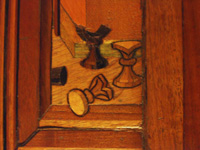 Fig. 2.65. Chess pieces, Urbino studiolo.The boundary between cipher and object is not always crisp. The ermine emblematically depicted in the dado is elsewhere suspended from the collar that Federico had received from the king of Naples; in each studiolo this collar dangles from a drawer or cabinet. Furthermore, the illusionistic shadows cast beneath the benches and within the cabinets "originate" from apertures in the rooms, blurring the distinction between actual and ideal.48 The more closely we investigate this "blur," the more contradictions arise. As Martin Kemp notes, the illusionism in the studioli is achieved "through an aggregate of compelling motifs which lead us to assume more overall coherence than is apparent on close analysis. We are, in effect, cunningly seduced into seeing more lucidity than the designer has actually supplied."49
Fig. 2.65. Chess pieces, Urbino studiolo.The boundary between cipher and object is not always crisp. The ermine emblematically depicted in the dado is elsewhere suspended from the collar that Federico had received from the king of Naples; in each studiolo this collar dangles from a drawer or cabinet. Furthermore, the illusionistic shadows cast beneath the benches and within the cabinets "originate" from apertures in the rooms, blurring the distinction between actual and ideal.48 The more closely we investigate this "blur," the more contradictions arise. As Martin Kemp notes, the illusionism in the studioli is achieved "through an aggregate of compelling motifs which lead us to assume more overall coherence than is apparent on close analysis. We are, in effect, cunningly seduced into seeing more lucidity than the designer has actually supplied."49
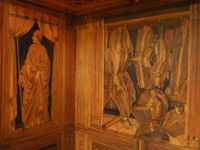 Fig. 2.66. Small scale portrait of Duke Federico. Fig. 2.66. Small scale portrait of Duke Federico. |
44At Urbino, in particular, we find a heterogeneous juxtaposition of scale and compositions. It appears, for example, that the four miniature figures of Federico and the theological virtues could inhabit the faux studiolo, whereas just next to the duke's portrait we see his armor at full scale. Likewise, compositionally, the fictive scene in the east wall does not continue to either side but is "interrupted" by the armory to the left and the miniature studiolo to the right.
45These discontinuities should not be considered "flaws" in verisimilitude; rather, they disclose that the prerogative of the studioli, like Cusa's religious icon, was to strike—even unsettle—the emotions of its observers. As an observer's movements "activated" certain images, sympathetically these images triggered the mind and emotions of the observer. Through their architectural arrangement and ornament, the studioli were conceived to stimulate movement in an observer's sensing body and apprehending intellect.
46When Alberti describes the appropriate nature of a work's historia, echoing Hugh of St. Victor's earlier recommendations for constructing a mnemonic "ark,"50 he foreshadows the arresting character of the Montefeltro studioli:
A "historia" you can justifiably praise and admire will be one that reveals itself to be so charming and attractive as to hold the eye of the learned and unlearned spectator for a long while with a certain sense of pleasure and emotion. The first thing that gives pleasure in a "historia" is a plentiful variety. Just as with food and music, novel and extraordinary things delight us for various reasons but especially because they are different from the old ones we are used to. . . . When the spectators dwell on observing all the details, then the painter's richness will acquire favour.51
47 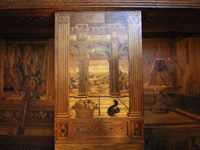 Fig. 2.67. East wall of Urbino studiolo.One particular figural arrangement that would have captivated Federico's guests is found at Urbino's east wall. Rebecca Tenzer has noted that the book press behind the image of the city is known in Latin as an armarium. The miniature studiolo to the right represents a place of study known also as an armariolum. Meanwhile, Federico's armor was known as arma, and an arsenal for arms and armor was called an armamentum. With weapons and instruments of scholarship interspersed throughout its cabinets, this etymological play—transparent to Federico's colleagues52—suggests that the entire Urbino studiolo may be interpreted simultaneously as an armariolum and armamentum, a witty spin on the traditional rhetorical trope of the vita activa and vita contemplativa.53
Fig. 2.67. East wall of Urbino studiolo.One particular figural arrangement that would have captivated Federico's guests is found at Urbino's east wall. Rebecca Tenzer has noted that the book press behind the image of the city is known in Latin as an armarium. The miniature studiolo to the right represents a place of study known also as an armariolum. Meanwhile, Federico's armor was known as arma, and an arsenal for arms and armor was called an armamentum. With weapons and instruments of scholarship interspersed throughout its cabinets, this etymological play—transparent to Federico's colleagues52—suggests that the entire Urbino studiolo may be interpreted simultaneously as an armariolum and armamentum, a witty spin on the traditional rhetorical trope of the vita activa and vita contemplativa.53
48  Fig. 2.68. Civic space, east wall, Urbino studiolo.Wolfgang Leibenwein has discerned another narrative from the east wall imagery, in the form of an ethical fable.54 "The prudent ruler [represented by the squirrel], enriched by the experience and humanity derived from his active/contemplative pursuits [the dialectic of armariolum/armamentum], provides for the well-being [the basket of fruit] of his state [the cityscape and surrounding lands]."55 Dwelling on the image of the squirrel, one wonders why it is shown wearing a collar. There was a careful distinction, it appears, between a prince who prudently gathers provisions and one who hoards: the collared squirrel with its nut does not suggest the domestication of nature but rather the domestication of human nature, namely the vice of avarice.56
Fig. 2.68. Civic space, east wall, Urbino studiolo.Wolfgang Leibenwein has discerned another narrative from the east wall imagery, in the form of an ethical fable.54 "The prudent ruler [represented by the squirrel], enriched by the experience and humanity derived from his active/contemplative pursuits [the dialectic of armariolum/armamentum], provides for the well-being [the basket of fruit] of his state [the cityscape and surrounding lands]."55 Dwelling on the image of the squirrel, one wonders why it is shown wearing a collar. There was a careful distinction, it appears, between a prince who prudently gathers provisions and one who hoards: the collared squirrel with its nut does not suggest the domestication of nature but rather the domestication of human nature, namely the vice of avarice.56
49 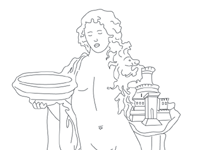 Fig. 2.69. Dinocrates presenting the model of a city to Alexander the Great.Even further rhetorical invention may be deduced from the east wall considering the broad interests of Francesco di Giorgio, who is generally regarded as the "author" of this area of the Urbino studiolo.57 In 1475 or 1476, di Giorgio presented a volume of architectural drawings to Federico, the Opusculum de architectura, that offered his services to the duke as Dinocrates had to Alexander the Great and Vitruvius had to Caesar Augustus. Di Giorgio's treatise was deeply influenced by Vitruvius's De architectura, a favorite of Federico's.58 In the preface to the Opusculum, di Giorgio claims to appreciate the value of work experience and daily reading, a choice of words that resonates with the intarsia design and the second passage of Vitruvius's treatise: "Architects who without culture aim at manual skill cannot gain a prestige corresponding to their labours, while those who trust to theory and literature obviously follow a shadow and not reality. But those who have mastered both, like men equipped in full armour, soon acquire influence and attain their purpose."59 Although the civic space of the east wall appears devoid of the type of historia found in di Giorgio's other works, including the Allegory of Discord of 1476, we may discern how the architectural ornament of this wall—and of the studioli in general—prepared (ornare) an observer with visual cues and subject matter for rhetorical invention.
Fig. 2.69. Dinocrates presenting the model of a city to Alexander the Great.Even further rhetorical invention may be deduced from the east wall considering the broad interests of Francesco di Giorgio, who is generally regarded as the "author" of this area of the Urbino studiolo.57 In 1475 or 1476, di Giorgio presented a volume of architectural drawings to Federico, the Opusculum de architectura, that offered his services to the duke as Dinocrates had to Alexander the Great and Vitruvius had to Caesar Augustus. Di Giorgio's treatise was deeply influenced by Vitruvius's De architectura, a favorite of Federico's.58 In the preface to the Opusculum, di Giorgio claims to appreciate the value of work experience and daily reading, a choice of words that resonates with the intarsia design and the second passage of Vitruvius's treatise: "Architects who without culture aim at manual skill cannot gain a prestige corresponding to their labours, while those who trust to theory and literature obviously follow a shadow and not reality. But those who have mastered both, like men equipped in full armour, soon acquire influence and attain their purpose."59 Although the civic space of the east wall appears devoid of the type of historia found in di Giorgio's other works, including the Allegory of Discord of 1476, we may discern how the architectural ornament of this wall—and of the studioli in general—prepared (ornare) an observer with visual cues and subject matter for rhetorical invention.
50 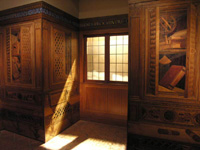 Fig. 2.70. An equivalent of the Urbino studiolo's east wall at Gubbio?All of these figural effects, pictorial and linguistic, contribute to a perception that the studioli were conceived to engage the entire body as well as the eye, a tactic that would enhance the memorability of the intellectual content of the chambers while conveying the artisans' mastery and the patron's magnificentia. To this end, the studioli provided the Montefeltro dukes with treasuries of images that were readily preserved within the memory, including that of a visiting dignitary, who would then recount to others the marvelous "sorts" of wisdom cultivated at the Urbino court. This propagandistic character, underpinned with influences of classical and medieval pedagogy, suggests that the studioli should be considered as idealized settings in which Federico and Guidobaldo would compose themselves and their thoughts as part of their responsibilities of governance.
Fig. 2.70. An equivalent of the Urbino studiolo's east wall at Gubbio?All of these figural effects, pictorial and linguistic, contribute to a perception that the studioli were conceived to engage the entire body as well as the eye, a tactic that would enhance the memorability of the intellectual content of the chambers while conveying the artisans' mastery and the patron's magnificentia. To this end, the studioli provided the Montefeltro dukes with treasuries of images that were readily preserved within the memory, including that of a visiting dignitary, who would then recount to others the marvelous "sorts" of wisdom cultivated at the Urbino court. This propagandistic character, underpinned with influences of classical and medieval pedagogy, suggests that the studioli should be considered as idealized settings in which Federico and Guidobaldo would compose themselves and their thoughts as part of their responsibilities of governance.
Notes
Note 1: The terra-cotta tiles were installed in the late sixteenth century. The floors of both studioli were originally of wood. Raggio, Gubbio Studiolo, 1:83. back
Note 2: Raggio, Gubbio Studiolo, 1:44. back
Note 3: Vespasiano da Bisticci, Vespasian Memoirs, 101. back
Note 4: Alberti, Art of Building, 10.14.356. back
Note 5: Thornton, Scholar in His Study, 43. back
Note 6: A book press is the traditional term for a cabinet set into the depth of a wall. back
Note 7: Castiglione, Book of the Courtier, 9. See also Alberti's analogy of the city-house/house-city in Art of Building, 1.9.23. back
Note 8: Alterations to this wing were not actually completed until after the death of Battista Sforza in 1472. According to Vespasiano, the privacy bestowed on this wing was continued into Guidobaldo's reign: "Federico's daughters, attended by many noble and worthy ladies, occupied a wing of the palace whither went no one but the Signor Ottaviano and the young prince." Vespasiano da Bisticci, Vespasian Memoirs, 107. back
Note 9: For an account of this indecorous episode, see Pernis and Adams, Montefeltro and Malatesta, 25. Federico, who was stationed in Pesaro, returned immediately to Urbino but was not permitted to enter the city to claim leadership until he had signed a constitutional agreement with the citizens. For the details of this pact, see Dennistoun, Memoirs of the Dukes of Urbino, 1:417–20. There has long been speculation that Federico was involved directly or indirectly in Oddantonio's murder to clear a path to the leadership of Urbino, though it is worth noting that Federico did not receive the title of duke for another thirty years, since it was nontransferable. Suspicion also surrounded Sigismondo Malatesta, who long aspired to annex Urbino to Rimini and was believed to have conspired to the young duke's demise with a younger brother, Malatesta Novello (also Oddantonio's brother-in-law), and Tommaso di Guido dell'Agnello of Rimini. For details, see Pernis and Adams, Montefeltro and Malatesta, 9–25. Local history has pointed to the possibility of an accident of uncertain authorship, a display of force gone awry. Whether for theater or in earnest, or a combination thereof, Federico pardoned the murderers, granted Urbino's citizens expanded privileges, and assumed governance. back
Note 10: "Oltre la libreria vi è una cameretta destinata allo studio nell'appartamento principale, d'intorno alla quale sono sedili di legno con gli appoggi ed una tavola nel mezzo: lavorato il tutto diligentissimamente d'opera d'intarsi e d'intagli. Dall'opera di legno, che così ricopre il pavimento come la muraglia d'intorno all'altezza di un uomo o poco più, infino alla soffitta, le facciate sono distinte in alcuni quadri, in ciascuno dei quali è ritratto qualche famoso scrittore antico o moderno con breve elogietto, nel quale ristrettamente si compendia la vita di ciascheduno di loro." From Baldi, Della vita e de'fatti di Montefeltro, cited by Cosimus Stornajolo (Codices urbinates graeci, xiv). My own translation, with assistance from A. Botta and A. Saiber. See also Vespasiano da Bisticci, Vespasian Memoirs, 101. back
Note 11: It is generally accepted that the Urbino studiolo was completed in 1476, the date presented in the dedicatory text. Since Federico is described as duke, a title he had been invested with by Pope Sixtus IV on 21 August 1474, we may assert that the chamber's decorative program was commenced at least as early as 1474. back
Note 12: The specific arrangement of these portraits and their surrounding ornament, convincingly reconstructed by Rotondi, Ducal Palace of Urbino, and Cheles, Studiolo of Urbino, point to several quattrocento debates. These, and differing opinions regarding the layout of the portraits, are addressed in chapter 6. For the written encomia that accompany the portraits, visit the Gallery of the Illustrious Men. back
Note 13: The duke and duchess occupied this group of rooms during the palace construction. back
Note 14: The seven-lobed flower is also unusual. A similarly patterned green textile appears in the background of Hans Holbein the Younger's The Ambassadors (1533). back
Note 15: Although Raggio (Gubbio Studiolo, 114) correctly identifies this explosive device as a petard, the term grenade is appropriate due to a play of words and images (with pomegranates) discussed in chapter 6. back
Note 16: Virginia Tenzer observes that the towers depicted in the intarsia are squared, whereas the torrecini of the ducal palace are cylindrical ("Iconography," 199). back
Note 17: Cheles, Studiolo of Urbino, 26. back
Note 18: Raggio, Gubbio Studiolo, 1:186n7. back
Note 19: Descriptions provided by Wilmering (Gubbio Studiolo, 2:apps. 4, 5) are from the nineteenth century. back
Note 20: I.V. #543. back
Note 21: Raggio, Gubbio Studiolo, 1:93. back
Note 22: Proposals by Lorne Campbell, Luciano Cheles, Cecil Clough, Marcin Fabianski, and Olga Raggio offer informative and conflicting evidence; without further original documentation, however, all arguments remain speculative. Although this debate is not central to my argument, I offer the following observations. Raggio's updated interpretation of the chamber's Latin inscription clarifies the relation between Justice and Piety, providing a convincing rebuttal to Campbell's doubts over the original presence of the paintings in the Gubbio studiolo (1998: "Justus of Ghent," 285–86). Raggio also regards the phrase Venerande Matris (Venerable Mother) as a key to understanding the text and its relationship to the theme of the liberal arts (Gubbio Studiolo, 1:160), a point with which I concur (for slightly different reasons) and develop in chapter 3. Although there is no shortage of views on the arrangement of the portraits, all agree on one point. The four surviving images each include the fragment of a dedicatory text depicted in a background cornice—the same text found in the cornice (and mini-studiolo) in the Urbino studiolo. This detail is generally accepted as a basic ordering principal, though there is disagreement over how the portraits fit into the wall space provided. Although all concur that the three verbal arts (Grammar, Rhetoric, and Dialectic) occupied the northwest wall and that Arithmetic and Geometry (both missing) more than likely occupied the northeast wall, doubt continues over the placement of Astronomy and Music. Were they on the wall with windows or over the entrance? Although the Music panel contains the conclusion of the text passage, hence logically completing the circuit of the room, several have urged that it could not have been above the entrance owing to the contradiction of its shadows and the actual positions of windows in the studiolo. This point does not dissuade Raggio (Gubbio Studiolo, 1:166), who cites the "indifferent" lighting conditions found in the East and West walls of the uomini illustri in the Urbino studiolo to explain the inconsistencies (for the debate regarding the portraits at Urbino, see chapter 6n70). It should also be noted that the source of illumination is not convincingly resolved if Astronomy and Music were located over (or between?) the funnel windows of the southeast wall, in spite of Clough's claims. Previously, Fabianski and Clough proposed schemes that include the seven Liberal Arts portraits and a larger painting by Justus of Ghent featuring Federico and Guidobaldo with a small group listening to a lecture, traditionally referred to as the Oration, which both place above the door. Fabianski's argument is founded on the presumption that the two funnel windows and the upper portion of the window niche were bricked in before the studiolo was installed (Fabianski, "Federigo da Montefeltro's Studiolo in Gubbio Reconsidered," 210). Raggio observes that precisely because these areas were not bricked, the studiolo could have accommodated only the Liberal Arts portraits (without the Oration), though her suggestion that the remaining wall surfaces in the upper windowed wall "probably also had a wooden revetment, probably without paintings," seems unlikely, given its inconsistency with the studioli compositions, with intarsia below and oil paintings above (Gubbio Studiolo, 1:83, 154). Meanwhile, Clough conjectures the following, based on an historical contract for the room's decoration: "Presumably the wall space in plum color was essentially the area around the openings of the two slant windows" ("Art as Power," 41), an interesting supposition for reasons I describe in chapter 5. Yet Clough's offering is self-contradictory, since he also suggests (in the same article) that the funnel windows were bricked in (23). He asserts: "I suggest it more likely that each of the Seven Liberal Arts was immediately above the seven cupboards of the marquetry," directing his reader to an image that depicts the portraits of Astronomy and Music over the funnel windows, effectively blocking them. It is also unclear exactly to which cabinets Clough refers, since there are ten cabinets represented in the central area of the studiolo and 13 in all (including the window niche with its missing shutters). His notion that the decoration of the Gubbio studiolo evolved and possibly changed during installation may, however, hold a grain of truth: it is conceivable that the area above the window (excluding the funnel windows) could have been filled in after the Liberal Arts cycle had been completed, providing new wall surface for either Astronomy and Music or the Oration (which would be a very close fit, if at all possible). But there is a preponderance of ifs in this rationale, so until further clues emerge, I find most tenable Raggio's recent layout (1999), with the slight adjustments to nomenclature provided in the following note. back
Note 23: Rhetoric and Music are at the National Gallery of London. Dialectics and Astronomy were destroyed in Berlin during World War II and exist now only in black-and-white photographic negatives. As to the identities of the kneeling figures, there is some consensus regarding Costanzo Sforza (Federico's brother-in-law) and Ptolemy/Ferrante I (Federico's patron from 1458), and Federico's profile, though aged, is undeniable. Less certain is the identity of the youth at the center of the northwest wall. Raggio's suggestion that this "could be Guidobaldo" (Gubbio Studiolo, 1:160) holds special merit if the painting cycle were completed in 1482 or 1483, when Guidobaldo would have been ten or 11. It is also difficult to imagine such a prominent position within the orthography of the studiolo occupied by someone other than the young prince, especially given the details found in the cabinet near the window. It should be noted that Raggio's view on the portrait with Federico has changed somewhat; she now states that the duke is portrayed with the goddess of Grammar rather than Dialectic (compare Raggio and Wilmering, Liberal Arts Studiolo, 32, with Raggio, Gubbio Studiolo, 1:159): "To the right a window leads the eye toward a room with an open door, the traditional symbol of the gateway to knowledge, which suggests that the allegorical figure leaning toward Federico should be identified with Grammar rather than Dialectic." This is an extremely tenuous thread. Grammar, the earliest stage of learning, would be more logically placed directly above the beginning of Veterani's distych. Most important, Vespasiano emphasizes Federico's passion for dialectical disputation, a more fitting characteristic for the duke's memorialization than rudimentary Grammar. back
Note 24: I.V. #492. Virgil Aeneid 310 (vv. 650–53). back
Note 25: Castiglione, Book of the Courtier, 9. back
Note 26: There are 24 objects found on the benches at Urbino and eight at Gubbio (including a perspectival butterfly from the missing panels below the window). Likewise, there are 94 (possibly 96) books depicted at Urbino and 32 at Gubbio. Urbino's cabinets contain approximately 148 items, compared with 74 at Gubbio. My technique for tallying the contents was uncomplicated: grouped items, such as the bundles of fasces or container of candied fruits, counted as one item. As a result, there are two bundles of fasces (rather than forty individual rods) and one container of candied fruits rather than 12 individual candies. Even with such inexact science the ratio of the respective contents is striking. back
Note 27: This manuscript originally displayed the text and score of O Bella Rosa (Urb. Lat. 1411, fols. 7r–9v), a popular song written in the style of Leonardo Giustiniani, that was interpreted by Johannes Ciconia and John Dunstable. Raggio, Gubbio Studiolo, 1:143. back
Note 28: Since the bench beside the lectern is raised, and the base of the lectern overhangs the exposed side edge of the seat beneath, it would appear that the bench seat had been raised while retrieving the lectern from the cabinet, which was then placed on the bench below. Although this procedural logic is consistent with similar upraised-bench/opened-cabinet arrangements at Urbino, it seems that the lectern would be too tall to fit within the cabinet unless the upper portion of the lectern were removed. back
Note 29: A geometrically faceted wooden ring used in fashionable Florentine headwear, such as that worn by Guidobaldo in his portrait with Rhetoric, directly above. It is also a figure favored for perspectival explorations by such artists as Piero della Francesca and Paolo Uccello. In the Urbino studiolo, the mazzocchio is found in a south wall cabinet. back
Note 30: Used in surveying and perspective, the butterfly was part of the intarsia beneath the window that has been destroyed. Fortunately, it was preserved by photographic record. back
Note 31: An ancient Roman symbol of authority, found in the Urbino studiolo in a north wall cabinet. back
Note 32: It is difficult to determine whether there is an unoccupied hook at the top of the cabinet above the portative organ. back
Note 33: The scopetta is similarly suspended. back
Note 34: Inconsistencies in the shadows have led some to suggest that the cycle of the Liberal Arts was not originally located in the Gubbio studiolo. Raggio's less radical position is more tenable (Gubbio Studiolo, 1:166–67). Inconsistencies in lighting are also found at Urbino, likely due to the same earthbound complications that confront contemporary craftsmanship—busy artisans, an over-reliance on assistants and, in the case of the Gubbio intarsia, the fact that they were fabricated at a distance, in Florence. back
Note 35: "Confusion," asserted Hugh of St. Victor, "is the mother of ignorance and forgetfulness, but orderly arrangement illuminates the intelligence and firms up memory." De Tribus Maximus Circumstantiis gestorum (quoted in Carruthers, Book of Memory, app. A, 261). See also Wilmering, Gubbio Studiolo, 2:107: "The Gubbio studiolo . . . is a more formal and perhaps more cerebral setting—a place for learning and conducting business." back
Note 36: Luciano Cheles observes: "for magnificentia to be of any political consequence, works of art needed to be displayed rather than secretly treasured" (Studiolo of Urbino, 91). It is also fitting that the pipe and tabor—instruments played during military marching—are placed alongside the candied fruit as a reminder of Guidobaldo's worldly responsibilities as a condottiere. back
Note 37: As I discuss in chapter 6, it is possible that an esteemed visitor may have waited unattended in the Urbino studiolo while the duke completed matters elsewhere. Otherwise, it is likely that Federico or one of his ministers would have been present to point out specific images and details in a manner akin to the medieval presentation of "ornatus" in a religious shrine. In Peregrinatio religionis ergo (ca. 1512), Erasmus recounts an abbot's jewel-by-jewel discourse at Canterbury, performed in the tradition of Abbot Suger of St. Denis. Bann, "Cabinet of Curiosities," 64–68. back
Note 38: It is worth noting the celebrated discovery of the Iguvian tablets in a farmer's field at Gubbio in 1444. These bronze tablets preserved the settlement rituals of the Umbrian civilization (composed right to left) alongside Latin translations (notated left to right). back
Note 39: Fundamental to writing and oration from ancient Rome, the progymnasmata trained students to work with visual figures and compositional units. Other examples in the studioli are addressed in chapters 3 and 4. According to Aphthonius, the progymnasmata comprised 14 exercises. His treatise, entered in the Indice Vecchio as "Aphtonius [sic] sophista, graec. 88," was bound together with Hermogenes' work on the subject (both in Greek). Other entries on the progymnasmata at Urbino included Libanius (I.V. #467, 468; graec. 78, 79, 81, 94–96) and Aelius Spartianus (I.V. #373; p. CXLIX, n. 47), who may represent Aelius Theon. See Kennedy, New History of Classical Rhetoric, 202–8. back
Note 40: "The men we call early 'humanists' generally described themselves as 'orator' or 'rhetoricus.'" Leonard, Into the Light, 206n8. back
Note 41: The emblems in the pilaster capitals, for example, do not appear elsewhere in other capitals. back
Note 42: "Skopos, a Greek word, is literally the target of a bowman, the mark towards which he gazes as he aims." This term was important, "not only in rhetoric, but also in the discourse of philosophical meditation." Carruthers, Craft of Thought, 79. back
Note 43: In each studiolo there are images (such as the latticework of the cabinet doors) whose anamorphic distortion guides the observer to a place from which the distortion appears to be "resolved." See Kemp, "Making It Work," 169–77. back
Note 44: Naturally, one wonders whose eye-height determined the horizon for the threaded discs. Federico's? Ottaviano's? An "average" viewer's? The artisan's? Guidobaldo cannot have been tall enough at the time the studiolo was completed. Might the height of Federico's eye have provided a natural measuring stick—a goal of sorts—for the young prince to grow into? We can only speculate. However, it is difficult to imagine that so specific a detail, which appears nowhere else in the studioli, would have been generated randomly. back
Note 45: Nicholas of Cusa, Vision of God, 42. Cusa's reference to Roger van der Weyden is found at 3. back
Note 46: "Our sight, through the mirror of the eye, can only see that particular object toward which it is turned." Cusa, Vision of God, 37. back
Note 47: Cusa, Vision of God, 43. The coincidentia oppositorum is a central tenet of Cusa's philosophy of learned ignorance, derived from Dionysius the Areopagite and articulated in Cusa's treatise De docta ignorantia (1440). "I have learnt that the place wherein Thou art found unveiled is girt round with the coincidence of contradictories, and this is the wall of Paradise wherein Thou dost abide." Vision of God, 44. back
Note 48: Taking Federico's monocular vision into consideration, one can imagine how marvelously real the cabinets and their contents would have appeared to the duke. back
Note 49: Kemp, "Making It Work," 174. back
Note 50: Recall the epigraph to this chapter. back
Note 51: Alberti, On Painting, trans. Grayson, 2.40. back
Note 52: Etymological invention was basic to a humanist education. The studioli are well stocked with examples of figural play between word and image. back
Note 53: Tenzer, "Iconography," 202. back
Note 54: Ethical fabulation, employing animals, is another of the progymnasmata exercises. back
Note 55: Liebenwein, Studiolo, 211–12n334. As cited by Cheles, Studiolo of Urbino, 64, with my clarifications. back
Note 56: For the Christian association of squirrels with avarice, see Cooper, Illustrated Encyclopaedia, 158. back
Note 57: Rotondi, Il palazzo ducale di Urbino, 1:348. Raggio, Gubbio Studiolo, 1:89. back
Note 58: Di Giorgio's treatise was accompanied by marvelous drawings of mechanisms, many of which were incorporated into the facade of the ducal palace through the hands of Ambrogio Barrocci, master sculptor. There were two copies of Vitruvius present in the ducal library: I.V. #291 and #292. back
Note 59: Vitruvius, De architectura, 1.1.2. Raggio, Gubbio Studiolo, 1:46. back
